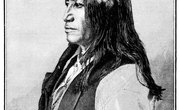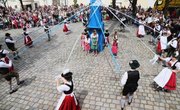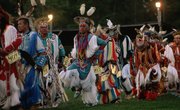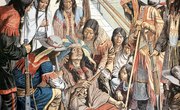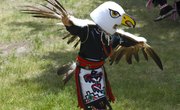Anasazi is Navajo for "ancient peoples" or "ancient enemies" and refers to a culture that flourished in the Southwestern United States between 1200 BC and the 13th century. The Anasazi are best known for their cliffside pueblos scattered across the Southwest. The exact nature of their religion is unknown, but it may have been similar to the religion the Hopi, who are considered to be the direct descendants of the Anasazi. Other American Indians often refer to the Hopi as "the oldest of the people." Traditions thought to date back to the 10th to 12th centuries are still kept by many Hopis.
Kachinas and Ceremonies
The kachinas are central figures in many indigenous religions of the Southwestern United States. They aren't gods exactly but more like nature spirits or demi-gods. The major dances of the Hopi ceremonial year feature dancers dressed as these powerful spirits. Like other American Indian tribes, Hopi religious ceremonies consist of chants, music, dancing and elaborate costumes. The ceremonies are timed according to a ceremonial calendar based on the position of the sun and stars.
Wuwuchim
The ceremonial year begins with Wuwuchim, a 16-day celebration that commemorates the first phase of creation. It includes the New Fire ceremony and initiation rites for the young men.
Soyal
Soyal is celebrated at the winter solstice. The ceremony depicts the arrival of the first kachina. His toddler-like waddle represents rebirth in the coming year.
Powamu
Powamu is the Hopi word for purification. The Powamu ceremony includes the Bean Dance where the kachinas are asked for the next planting and the initiation of children into the various tribal societies.
Niman
Niman or the Home Dance is the final kachina dance of the year. It represents the return of the kachinas to their spiritual home in the mountains. While all Hopi dances have religious overtones, they are not as significant as the kachina dances.
Other Religious Dances
Some other dances include the buffalo dance, the snake dance and the flute dance. The buffalo dance commemorates the time when the buffalo were still plentiful and could be hunted. During the snake dance, Hopi religious leaders handle snakes and even put them in their mouths without being bitten. After the ceremony, the snakes are released into the wild to carry messages to the rain. The flute dance alternates with the snake dance and glorifies the spirits of the recently deceased.
Related Articles
Writer Bio
Frank B. Chavez III has been a professional writer since 2006. His articles have appeared on numerous websites including WitchVox and Spectrum Nexus as well as in the e-magazine Gods and Empires. He has his associate degree with an emphasis in theater arts from Chabot College, where he received the theater department's Joeray Madrid Award for Excellence in Dramaturgy.



